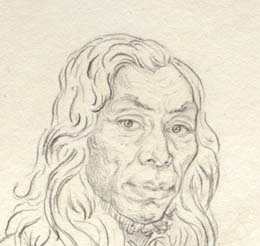On June 17, 1811, David Thompson (1770-1857), Canadian explorer, geographer, and fur trader, sets off from Spokane House, the North West Company's trading post on the Spokane River. Along the way, he records the first written account of the landscape and inhabitants of the Colville Valley in his field journals. Thompson, a partner with the North West Company of Montreal, has recently pioneered a new trade route across Athabasca Pass in the Canadian Rockies, and is bound for Kettle Falls, where he will prepare to descend the Columbia to its mouth to determine if the Great River of the West is navigable to the sea.
Many Musketoes
On June 17, complaining that strayed horses had delayed his departure from Spokane House until the late hour of 8:45 a.m., Thompson and a small party of Iroquois and French Canadian voyageurs set off on horseback and headed northwest along an Indian trail that he called the Ilth Koy ape Road. “The Road of the morning good but hilly, the soil sandy, rocky & much small gravel at times,” he noted in his journal. After cutting a point of the Spokane River where its course makes a tight bend southward, near modern Tum Tum, the trail left the river and continued north toward Chamokane Creek, where the party camped. After butchering an old horse for dinner, the men turned in for the night along with “Very many musketoes & very troublesome” (Thompson, June 17, 1811).
Awakening the next morning to thunder and lightning, Thompson was visited in camp by a free hunter who was trapping nearby. By 7:30 the surveyor and his crew were back on the trail, which continued northwest, crossing several brooks and creeks that form the headwaters of the Colville River, which Thompson referred to as the “Main Brook.” Along the way they paused to purchase a sack of roots from a group of Indians and, a little farther along, stopped to visit with a small native camp. Here they met a French-Canadian named Reve, or Rivet, another of the independent trappers who were moving into the area to trap for the North West Company. After resting their horses, they continued north through the Colville Valley, over “fine ground ... seems very fit for cultivation, black deep mould” (Thompson, June 18, 1811).
From the Colville River to Kettle Falls
On June 19, Thompson found that the trail crossed the Colville River (a few miles north of present-day Arden). He sent one of his men to a nearby camp to hire a canoe to ferry their cargo across, for which he paid six inches of tobacco. He bartered an additional 12 inches of tobacco for roots and fish, then purchased 22 muskrat skins before setting off again.
Near present-day Colville, he visited a small camp of Ilth-koy-ape Indians, then continued on to the landmark of Kettle Falls, where the spring salmon run had just begun. “We arrived all safe on the Banks of the Columbia River, at the Ilth Koy ape Falls, and the natives sent a present of a Salmon; to me, a most agreeable change from Horse Meat. Here we have to build a large canoe of Cedar Wood, or Birch Rind, to navigate the River to the Pacific Ocean” (Thompson, Travels, Vol. 2, 236).

